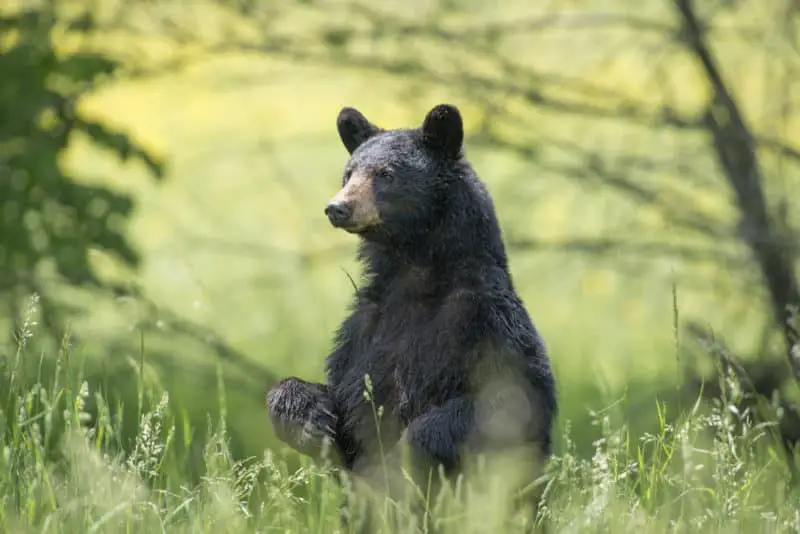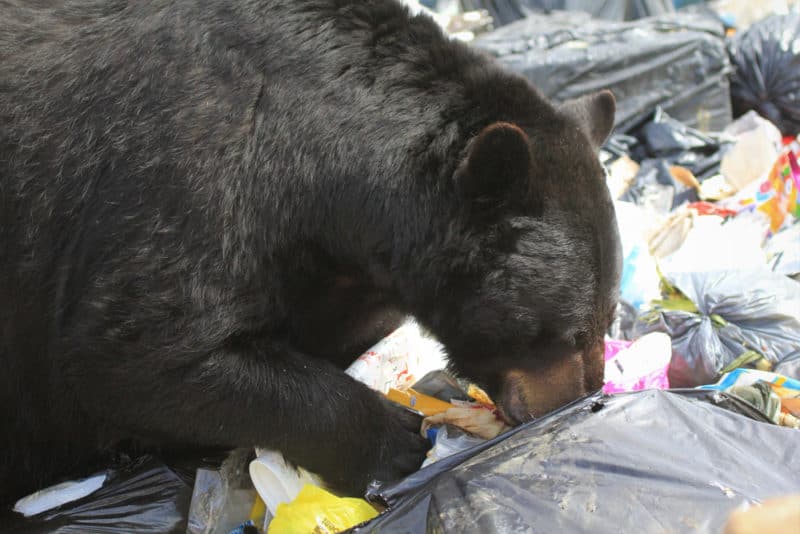Pennsylvania has a large, thriving bear population. Bear numbers in the state are down a bit in recent years, but there are still plenty of them. In 2020, the official bear count estimate was 20,000. That count went down to 16,268 in 2021, and now, in 2022, the black bear population in Pennsylvania is 15,666 animals.
This is a rather big drop. However, according to Pennsylvania Game Commission bear specialist Emily Carrollo, there is no reason for concern. The overall bear population in the state is healthy, with almost 16,000 animals. What’s more, the state bear population has seen two other similar drops following high bear harvests in recent decades.
In 2019, Pennsylvania bear hunters had an all-time record harvest of 4,653 animals. The bear season stats in 2020 and 2021 were also relatively successful.
Of the 3 species of bears living in North America, Pennsylvania has only 1 of them, and that is the American Black Bear, ” Ursus americanus “. The two North American bear species that Pennsylvania does not have are brown bears/grizzly bears and polar bears.
Black bears are the unrivaled apex predator in the keystone state. Mountain lions have been expatriated from Pennsylvania since 1865, and the only known wildcat species in the state is the bobcat.

Black Bears
Where do black bears live?
The black bear’s scientific name, Ursus americanus, means American bear in English. They are the most common and well-known bears native to North America. Their range begins in Alaska and northern Canada and extends south into central Mexico. Only 9 of the contiguous U.S. states don’t have breeding black bear populations. In Pennsylvania, there are breeding populations of black bear in over 75% of the state, and bear sightings have been reported in all 67 of its counties. However, areas that are largely agricultural or urban such as the southeastern corner of Pennsylvania and also parts of the western border, lack the forest cover that bears need. Consequentially any bears that are sighted in such areas of the state are more than likely just passing through. See
The average size of home ranges for adult male bears in Pennsylvania is 20 square miles, while the average size for females is 6 to 8 square miles See
What do black bears look like?
Adult black bears are anywhere from 50 to 85 inches long from the tip of the nose to the tip of the tail. Their average height is around 30 inches at the shoulder. The normal black bear’s weight range is from 140 to 400 pounds. However, males can be up to 70% larger than females, and some giant-sized individuals weigh over 800 pounds. The heaviest black bear ever harvested came from Pike County, Pennsylvania. It weighed 875 pounds.
Even though they are named black bears, their colors can vary from black, blue-grey, cinnamon, brown, blue-black, and on infrequent occasions, a black bear can even be white. Although most Pennsylvania bears are black, a small percentage of them are cinnamon-colored. Some black bears have a V-shaped white patch on their chest.
They have long brown snouts, short tails, and small brown eyes, although their eyes are blue at birth. Black bears lack the shoulder hump that brown bears or grizzly bears have. In areas that both species inhabit, the hump, or the lack thereof, is a distinguishing feature. Any wild bear in Pennsylvania will be a black bear, though.
Pennsylvania black bears are large
Prime bear habitat is abundant in Pennsylvania. The state has some large forested areas. Most of these consist of mixed hardwood forests with blackberries and blueberries growing beneath the forest canopy. With ample food availability, Pennsylvania’s bears are able to grow to their full genetic potential. Here are some examples.
- Average adult black bears can range from 140 to 400 pounds. However, the heaviest bear ever taken was in Pike County, Pennsylvania, in 2010. It weighed 875 pounds. See
- In 1987 the second largest black bear by Boone and Crocket measurements was killed by a poacher in Lycoming County. The bear’s skull measurement was 23-3/16 inches. This is second in size only to a bear that was found dead in Utah. This bear had an official measurement of 23-10/16. inches. See
- In 2020 a 633-pound black bear was struck by a truck and killed in Potter County. See
- In 2021 a central Pennsylvania hunter killed a 722-pound bear in Franklin County. See
Counting Pennsylvania’s population of bears
According to Emily Carrollo, who is the Pennsylvania Game Commission’s black bear biologist, the state trapped, tagged, tattooed, and released around 700 black bears last year in 2021 in its yearly program. They give ear tags and lip tattoos to these bears as a way to help them estimate the overall black bear population. See
Here is how they accomplish this. For example, Pennsylvania’s bear harvest in 2021 was 3,659 bears. The Game Commission keeps a database of every tagged bear. By law, Pennsylvania hunters have to bring every bear that they bag to a checking station operated by the Pennsylvania Game Commission. A percentage of those 3,659 were tagged bears. Wildlife officials can then assume that the percentage of tagged bears will be roughly the same in the harvested bears as it is with the total population.
We don’t have all the exact variables, but we do know that 3659 bears were harvested in 2021, and the official estimated population for 2022 is 15,666 bears. The next numbers will be hypotheticals. Let’s say that 4.46% of the harvested bears had ear tags in 2021, and the total amount of tagged bears was 700. we would next need to ascertain what number 700 is 4.46% of. The answer, of course, is 15,666.

How to make your home less attractive to bears
In Pennsylvania, the woods grow right up to some agricultural areas, suburban areas, and even urban areas. Consequently, sometimes humans find themselves living in close proximity to bear country. Sometimes the bears are attracted into close quarters with human populations by their keen sense of smell. Here is an example of what I’m talking about from 2016 in Berks County.
Black bears are not grizzly bears. They are generally non-aggressive. Some people take for granted that they don’t need to be cautious around them. This is not the case. These animals are still dangerous apex predators. Black bears that have been habituated to human food or garbage, as well as black bears that are in a hyperphagic state as they prepare to go into their winter den, can be especially dangerous.
Aside from that, they can potentially cause significant damage to your home and or vehicles. For example, if a black bear smells food in your parked car, it is capable of tearing the door off to get to it.
The following tips will make your property less attractive to wandering bears.
Pet food
It’s a bad idea to feed your outside pets more than they can efficiently clean up before dark. It’s also a bad idea to store your pet food outside. If you store your pet food outside, keep it in a bear-proof container.
Barbeque grills
Backyard barbecue grills are bear attractors. You Should clean your barbecue grill after every use and store it inside. If you live on a large property, dispose of your grease drippings and food waste in an area far away from your home. For the majority of people, though, who don’t live on a large acreage, the best thing to do is to store your grease drippings and food waste in the refrigerator until the day of your garbage pickup and then throw it away just before the garbage truck comes. Along this line, you should also store indoors and clean and disinfect your garbage cans regularly.
Vehicles
Keep all food or empty containers that have had food in them out of your vehicles. Bears have a keen sense of smell. Furthermore, as I mentioned earlier, an adult black bear is capable of bending your car door in half if it decides it wants to get inside.
Use electric fencing
If you have a vegetable garden, a chicken coop, an orchard, bee boxes, or any other outside bear attractants, you should consider using electric fencing to keep the bears at bay.
Bird feeders will attract bears.
Also, bird feeders have the potential to bring bears to your property, whether that be hummingbird feeders or ones that dispense out bird seed.
Never feed the bears.
A huge mistake that people sometimes make is to put food out to attract bears on purpose. When you do that, you create a situation that is beyond your control.
When bears begin to associate people with food, they lose any fear of humans that they might have had. They also might act out aggressively if they decide that you’re not giving them the food that they want and are accustomed to. Bears that are habituated to getting food from humans will have to be euthanized.
According to Dustin Stoner, who is an Information and Education supervisor for the Pennsylvania Game Commission, many times when you have a nuisance bear roaming your property, it will be during mating season, which runs from the end of May through early July. During this time, juvenile males will be more likely to roam as they are looking for to territory to establish themselves and, of course, females to mate with. See
If you should come upon a bear on your property, don’t try to handle the situation on your own. Keep a safe distance and call your local game warden.
How dangerous are black bears?
Black bears are generally a non-aggressive species of bear. They are omnivores, and in some cases, 96% of their diet is plant material. Additionally, when you surprise a black bear, they are much more likely to run away than to come toward you. However, between 2001 and 2021, black bears killed 28 people in North America. As you can see, black bears are not non-aggressive all the time.
Bear attacks fall into 2 categories. The first is defensive, and the second is predatory. 90% of black bear attacks on humans are predatory. Additionally, they’re almost always perpetrated by young adult males in the late summer or fall.
At this time of year, bears are going through a hyperphagic stage where they are packing on fat prior to going into their winter dens. Bears that were eating around 8,000 calories per day start taking in up 20,000 calories per day when they enter hyperphagia. It’s extremely rare, but sometimes these hyperphagic bears see humans as a potential food source.
88% of the fatal attacks carried out by black bears on humans between 1960 and 2009 were predatory and not defensive in nature and were carried out by lone male bears. This means that in the case of black bears, a female bear with cubs is less dangerous than a predatory male bear. Source
See here on how to recognize a predatory bear and what to do if you encounter one.
Recent Posts
The only venomous snakes in Washington State are Northern Pacific Rattlesnakes. The Northern Pacific Rattlesnake (Crotalus oreganus oreganus) is a sub-species of the Western Rattlesnake. Anyone...
Skunks are not classified as true hibernators. But they go into a state of torpor when the weather gets cold. Skunks are light sleep hibernators, along with opossums, bears, and raccoons. ...

